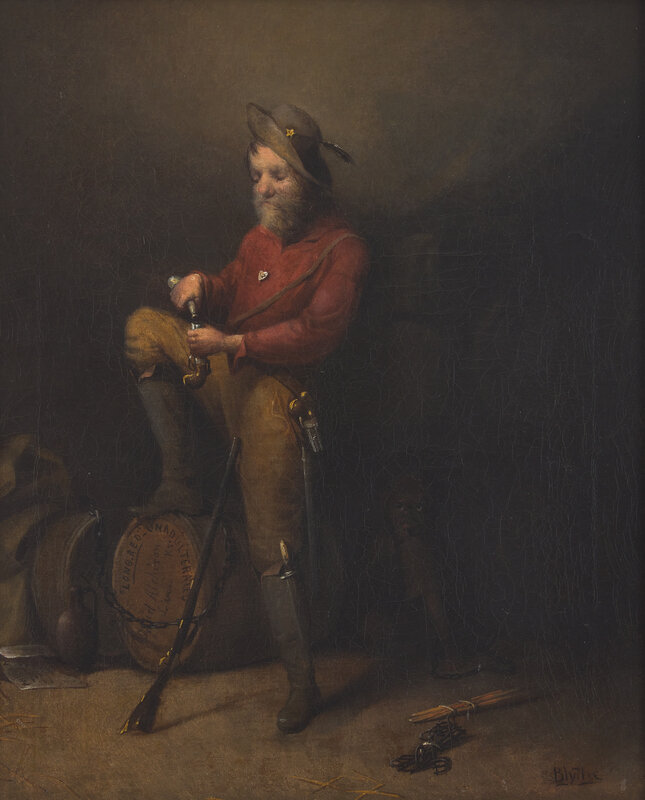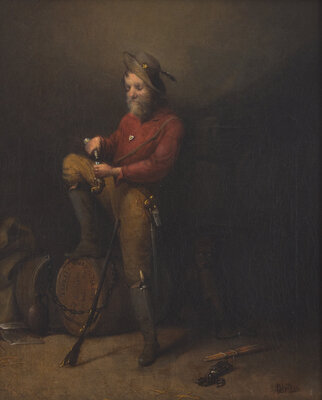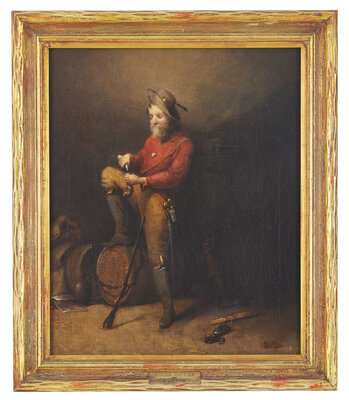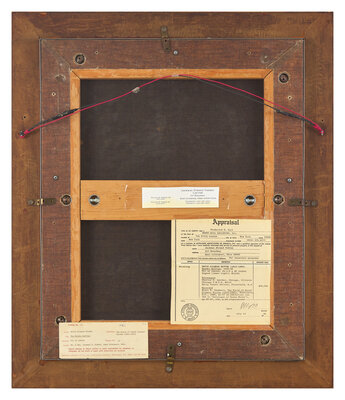Condition Report
Contact Information
Auction Specialist
Lot 9
David Gilmour Blythe
(American, 1815-1865)
The Border Ruffian, 1856-59
Sale 2105 - American Art and Pennsylvania Impressionists
Dec 8, 2024
2:00PM ET
Live / Philadelphia
Own a similar item?
Estimate
$50,000 -
80,000
Price Realized
$38,100
Sold prices are inclusive of Buyer’s Premium
Lot Description
David Gilmour Blythe
(American, 1815-1865)
The Border Ruffian, 1856-59
oil on canvas
signed Blythe (lower right)
24 1/4 x 20 in.
Provenance:
Charles S. Gunther, Chicago, Illinois, by 1919.
Chicago Y.M.C.A. Hotel, Chicago, Illinois.
Sally Turner Gallery, Plainfield, New Jersey.
Acquired directly from the above, 1974.
Private Collection, East Liverpool, Ohio.
By descent in the family to the present owner.
Literature:
Bruce W. Chambers, The World of David Gilmour Blythe (1815-1865), Washington, DC, 1980, pp. 86-87; 149, no. 103, fig. 58, illus.
The Times, Trenton, New Jersey, July 20th, 2007, G-3 (illus).
Exhibited:
Washington, DC, Smithsonian American Art Museum, The World of David Gilmour Blythe (1815-1865), October 17, 1980 - January 11, 1981 (traveling to Memorial Art Gallery of the University of Rochester, Rochester, New York, February 7 - March 29, 1981; Museum of Art, Carnegie Institute, Pittsburgh, Pennsylvania, May 9 - July 5, 1981).
East Liverpool, Ohio, Kent State University, David Gilmour Blythe: The Art and Life of a Native Son, 2003 (illustrated p. 3 in the accompanying exhibition catalogue).
Princeton, New Jersey, Princeton University Art Museum, '57 Collects: A 50th Anniversary Celebration, no. 15 (illustrated p. 15 in the accompanying exhibition catalogue).
Lot Essay:
David Gilmour Blythe, a self-trained artist with a satirist's eye and a keen dramatic sense, is best known for his depictions of the urban working poor. Born in 1815 in East Liverpool, Ohio, he permanently moved to Pittsburgh in 1855 after years of itinerant wandering and work. Although he began his artistic career painting portraits, Blythe was eventually drawn to the brutal reality of the industrial, gritty city, and captured the dirty faces of street urchins at play, pickpocketing hooligans, and street vendors hawking wares.
Prior to settling in Pittsburgh, in the early 1850s, Blythe traveled throughout the Midwest, where he satirized in art the political figures and the problems they caused. He used this material for later paintings, including the present example, The Border Ruffian, which refers to a troubled, yet important, moment in American history: the issue of the expansion of slavery into U.S. territories, which would ultimately be amongst the several causes of the Civil War. Specifically, the painting is to be understood in the historical context of Bleeding Kansas or the Border War, a series of violent civil confrontations that occurred in the mid-1850s along the border between Kansas and Missouri. The situation pitted “free staters,“ who fought against the expansion of slavery, against so-called “Border Ruffians,” who envisioned the territory a slave state. These tragic events were extensively covered in local newspapers and across the entire country. Blythe, like many, followed the events with great attention.
The subject in The Border Ruffian is shown as a frontier man, replete with not only a rifle and two pistols, but also a knife strapped to his leg and a sword at his hip. He stands in an undetermined setting, his right foot resting on a barrel, as he pours powder from a horn into a derringer pistol. He is the visual epitome of the rough and tumble Western world and would have been seen as a titillating contrast to the artist’s civilized and wealthy Northern clientele.
Based on the inscription written on the barrel on top of which he leans, the character acts as an evocation of David Rice Atchison (1807-1886), a lawyer born in Kentucky, who moved to Liberty County, Missouri in 1830. There, he served as a legislator until his appointment to the U.S. Senate in 1843. Re-elected in 1849, he served again until 1855, when he was defeated in one of the more riotous election campaigns that state had ever seen, followed by a series of violent raids and attacks against his opponents in Lawrence, KS.
An important figure in the Missouri state militia as well, Atchison was a leader of the pro-slavery faction in Missouri and an active supporter of the Border Ruffians. In 1854, he delivered a speech in which he vowed to “draw blood” and boasted of the “blood red flag” that he and his men carried in defense of Southern rights. He further vowed to kill and draw the blood of those who opposed slavery in Kansas. The words “Long Red Unadulterated” inscribed on the barrel are probably a reference to Atchison’s frequent reference to drawing the blood of the abolitionists. It may also be a reference to the “Red Stockings,” an abolitionist group who sported high red socks to connote their membership. It could also refer to whiskey as Blythe, a staunch Presbyterian, often took a dim view of others' drunkenness, lampooning it wherever possible. With his rounded features, heavy eyes, bulbous nose, and ruddy complexion, the man is tantamount to a caricature of himself, and therefore of his views.
Blythe was an ardent supporter of abolition and by extension, would have opposed expansion of slavery into Kansas territory. In the present painting, he reveals the uncivilized nature of the Border Ruffians, their violent character, and their unrepentant desire to make Kansas open for slavery. Through the heartfelt presence of the enchained black boy in the background shadows, Blythe wants to make certain his viewers remember the ultimate cause of Kansas violence is slavery, while leaving no doubt as to who the perpetrators of bloodshed really are.
As Blythe's habits in political caricature were consistently topical, the present painting was likely painted soon after Atchison's demise, thus making it Blythe's earliest political caricatures, and echoing the artist's general discontent and lamentation over the country's corrupted and violent political state.
Kansas was finally admitted into the Union as a Free state in 1861, following Lincoln's visits in 1854 and 1859.





